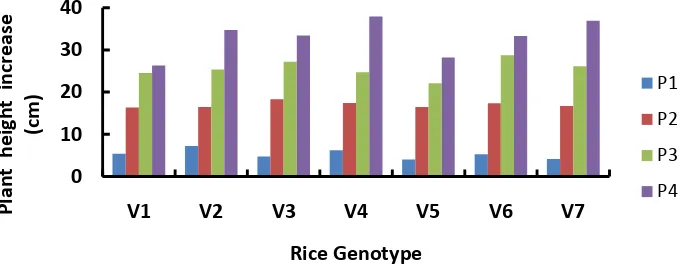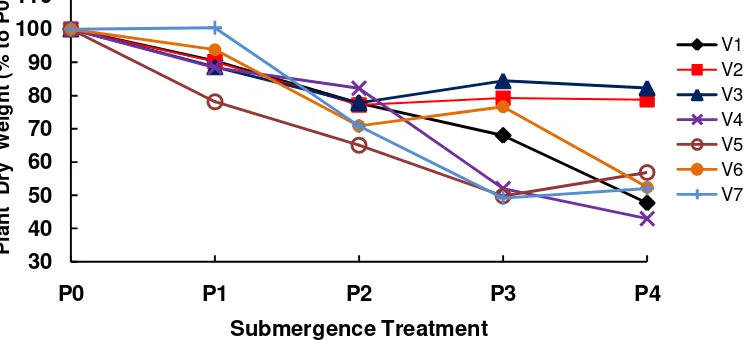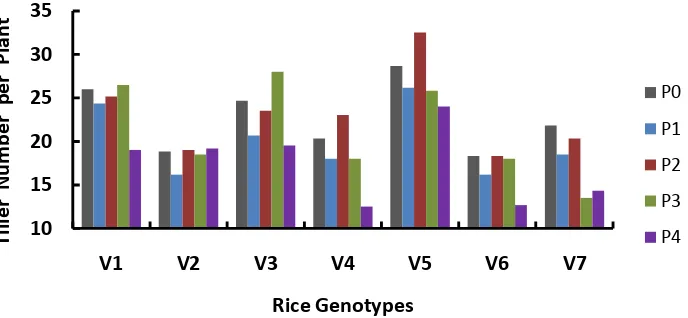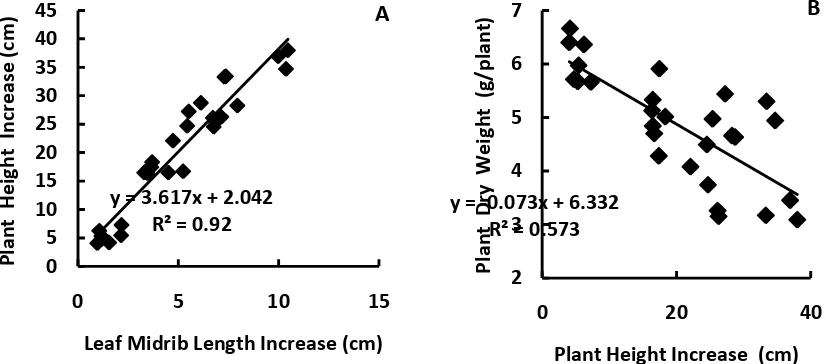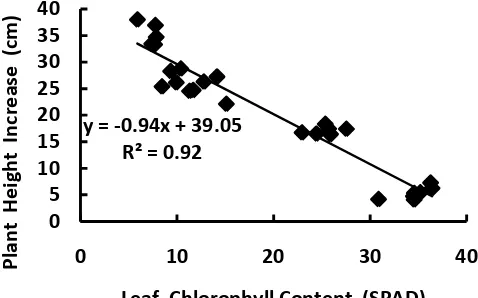Suwignyo, Effect of Submergence …… C-4-1
EFFECT OF SUBMERGENCE STRESS AT EARLY VEGETATIVE STAGE
ON THE AGRONOMIC CHARACTERISTICS OF SOME RICE GENOTYPES
Rujito Agus Suwignyo
Jurusan Budidaya Pertanian, Fakultas Pertanian Universitas Sriwijaya Jalan Palembang-Prabumulih Km. 32,5, Inderalaya 30662, Sumatera Selatan
ABSTRACT
A research to identify the effect of submergence stress on the growth of rice plants was done at the green house and the field of Faculty of Agriculture, Sriwijaya University with factorial randomized block design. Seven genotypes of rice used were B 5244g-Sm (V1), B 7003d-Mr (V2), B 6996d-Mr (V3), B 5565d-13g-Sm (V4), IR 37664 (V5), Kapuas (V6), and Siputih (V7); and the submergence treatments were P0 (no submergence), P1 (one day submergence), P2 (three day submergence), P3 (five day submergence), and P4 (seven day submergence). The result showed that submergence affected the growth of rice at vegetative stage, and the rice genotypes tested had their specific response not only during the submergence treatment period, but also during their recovery phase after submergence treatment terminated. Rice genotype of B 5244g (V1) and B7003d (V2) showed better agronomic characteristics and have possibility to be used as new rice strain that have submergence tolerance at vegetative stage. Some plant characters that might have important effect to improve plant recovery ability after submergence are leaf chlorophyll content after submergence and low height addition during submergence.
Key words: Rice, Submergence Stress, Vegetative Stage
INTRODUCTION
Freshwater swampland fields have been long considered to have a great potential to support the increasing of rice production in South Sumatera. Excess water during rainy season adversely affects rice productivity in these areas. In deepwater areas, water stagnation can occur for more than 6 months and to a depth of more than 100 cm. Rice cultivation in rainfed freshwater swampland fields is often subjected to flash floods that are unpredictable and can occur at any rice growth stage (Ito et al., 1999; Visser et al., 2003), and therefore submergence damage is a major factor limiting rice production in areas prone to such flooding (Kotera and Nawata, 2007). Rice farmers usually adapt to these conditions through adapted cultivation methods (Uchida and Ando, 1990; Suwignyo et al., 1998), optimized drainage management (Otsubo et al., 2000), or planting rice varieties with shoot elongation to expose their leaf tips above the water surface and survive by avoiding complete submergence (Setter and Laureles, 1996).
Lowland swamp lands have significant potential in increasing agricultural production, especially rice, although it is not optimally utilized. Planting rice in this area often experiences unpredictable flooding events and it can occur at various phases of rice plant growth (Visser
Suwignyo, Effect of Submergence …… C-4-2
rice plant tolerance submergence to stress (Sharma and Ghosh, 1999, Grigg et al., 2000), improving the method of cultivation management (Uchida and Ando, 1990; Suwignyo et al., 1998; Balai Penelitian Pertanian Lahan Rawa, 2008), and optimizing the management of drainage (Otsubo et al., 2000). Various efforts are essential in order to eliminate the problem of submerged rice plants, but it also should be supported and developed based on an understanding of the interaction between the fluctuations of water and rice submergence stress tolerance.
Under submergence conditions, plant growth will be disturbed, especially because of the underwater environment, the diffusion of gas 104 times slower than in air, thus inhibiting the rate of gas exchange (O2 and CO2) between plant tissue and the atmosphere (Kende et al., 1998; Gibbs and Greenway, 2003). Dangerous influence of the low gas exchange during submergence is limited or even termination of aerobic respiration and photosynthesis. This condition causes the energy crisis in the plant body during the stress. In relation with it, Das
et al., (2005) mentioned that the ability of plants to maintain a high carbohydrate in a post submergence stress is one important of crop tolerance characteristics.
One of the key factors that also affect the response of rice plants to the submergence stress condition is plant ethylene metabolism (Fukao and Bailey-Serres, 2008). Diffusion inhibition of hormone ethylene will cause ethylene accumulation in plants, which promotes stem elongation, root adventif formation, aerenchyma development, and ethanol fermentation (Drew, 1997; Fukao et al., 2006), and post-submerged inhibition of antioxidant mechanisms (Kawano, et al., 2002).
Varietal development efforts should be directed through the breeding program in accordance with local conditions. Some varieties produced should also be directed to the appropriate area planted with ecological needs of plants (Puslitbang Tanaman Pangan, 2004). Susanto et al., (2003) mentioned that narrow parental genetics background is the limiting factor to increase rice yield potential in Indonesia. To overcome this, through the crossing by using various sources of genes from indica, japonica and wild rice, has produced various types of new rice strains that have the potential higher yields (Abdullah et al., 2008). Development of submergence stress tolerant varieties began to receive attention in IRRI since the year 1993 (Mackill, 2007). Some resistant strains consisting submergence gene sub-1 have been generated (IRRI, 2007), and it began producing new submergence tolerant varieties in Indonesia (Suprihatno, et al., 2009).
Suwignyo, Effect of Submergence …… C-4-3 MATERIALS AND METHODS
This experiment was conducted in a greenhouse and experimental field of Faculty of Agriculture Sriwijaya University, using a randomized block design arranged in a factorial, with three replications and each replication consists of two plants. Rice genotypes used consisted of B-Sm 5244g (V1), B 7003d-Mr (V2), B-Mr 6996d (V3), B 13g-5565d-Sm (V4), IR 37,664 (V5), Kapuas (V6 ), and Siputih (V7). V1-V5 genotype strains are cross breeding strains aimed tolerant to lowland swamp land condition. Submergence treatments consisted of P0 (no submergence), P1 (one day submergence), P2 (three days submergence), P3 (five days submergence), and P4 (seven days submergence). Rice seeds were germinated for three weeks in a soil media in the greenhouse after water imbibition treatment for 24 hours. Germination media was a plastic tub of 40x30x13 cm3, and filled with soil of 8 cm depth. Seedlings were moved into a 10 kg polibag containing soil swamp media that previously cleared, ground and sieve at 5 mm filter. Fertilizer used was urea, SP 36 and KCl with equal doses of 100:127:100 kg/ha. Submergence treatment was performed on a water bath with water surface of ≥ 5 a ove the pla t. Submergence period was done according to the treatment and initiated two weeks after seedling transplanting to polibag. Submergence treatment was always attempted with the plants submerged under water. Observations measured were plant height, tiller number, leaf length, leaf chlorophyll content, leaf area, and plant dry weight.
RESULT AND DISCUSSION
The results showed that rice genotypes tested had different response with submergence treatment. Submergence period treatment provides a significance effect on the observed variables except the rate of stem length addition. The result of plant height growth after termination of submergence treatment can be seen in Figure 1. All genotypes tested showed an increase in plant height expansion with the longer of submergence treatment. Genotype B 5244g (V1) and IR37664 (V5) showed a relatively lower plant height expansion in the 7-day submergence treatment (P4) compared with those of other genotypes. Vriezen et al. (2003) mentions that plant height expansion of rice is one survival strategy under submergence condition, this process is strongly related to many physiological mechanisms, metabolism, and also the interaction among phytohormon ethylene, giberellin, and absisic acid. Saika et al. (2007) further showed that the rapid decline in hormone ABA is a requirement prior to the elongation of rice plant under submergence stress. The decreasing of ABA concentration is controlled by ethylene formation gene expression, OsABA8ox1.
Suwignyo, Effect of Submergence …… C-4-4
tolerance to submergence condition. Setter and Laureles (1996) reported a negative correlation between the survival percentage with stem elongation capability, and it is because the process of plant stem elongation will result in plant energy loss. Although the acceleration of stem elongation during submergence condition is a strategy to avoid stress and the plant will make the recovery process as soon as possible after submergence stress terminates, Kawano et al., (2009) states that the tolerance of rice plants will be greater if the acceleration of stem elongation under submergence stress is minimal.
Figure 1. Plant height expansion in some rice genotypes (V1 = B 5244g, V2 = B7003d, V3 = B6996d, V4 = B5565d, V5 = IR37664, V6 = Kapuas, V7 = Siputih) after termination of one day (P1), three days (P2), five days (P3), and seven days (P4) submergence treatments
Table 1. Effect of submergence treatment period on plant height (cm) of some rice genotypes two weeks after termination of submergence treatment
Rice genotype
Submergence treatment period (day)
0 1 3 5 7
B5244g 53.80a 54.87a 57.28ab 54.56ab 49.75a B7003d 65.88c 67.42b 63.03b 68.03c 68.27c B6996d 55.67ab 59.36ab 57.10ab 54.73ab 63.10bc B5565d 65.53c 66.35b 66.97b 60.10b 62.65bc IR37664 52.05a 53.59a 52.87a 51.52a 55.17a Kapuas 58.50b 67.32b 65.03b 66.70c 65.35bc Siputih 60.43bc 61.52b 61.80b 60.05b 61.73b
Numbers on the same column followed by the same letter are not significantly different at 5 % of honesty statistically different
Suwignyo, Effect of Submergence …… C-4-5
treatment termination would also be ended. Rice plants that have a moderate elongation characters can reduce the use of stem carbohydrates during submergence (Cho and Kende, 1997, Vriezen et al., 2003). Khan et al. (1987) shows that stem elongation rate will be higher at the beginning of submergence treatment and it will decrease afterwards. Setter et al. (1997) concluded that there are three important things in plant response to submergence stress tolerant, i.e: a) maintaining high concentration of plant carbohydrate before, during and after immersion, b) increase the rate of alcoholic fermentation, and c) maintaining the energy conversion with slow rate of stem elongation.
Figure 2. Effect of submergence on plant dry weight two weeks after termination of submergence treatment in several rice genotypes. Explanation in the figure is the same as shown in Figure 1.
The ability of plants to maintain plant dry weight under longer submergence treatment period showed a different response of rice genotypes tested (Fig. 2). Rice genotype of B7003d (V2) and B6996d (V3) showed better tolerance with low decrease of plant dry weight under prolong seven days submergence treatment (P4). Rice genotype of B 5244g (V1) and Kapuas (V6) can survive quite well until five days submergence treatment, whereas genotype of IR37664 (V5) tends to have the highest dry weight reduction from one day submergence treatment. Jackson et al. (1987) mentions that IR42 rice variety is not tolerant to submergence stress and decrease the accumulation of dry weight and dissolved carbohydrates in the stem more than 75% after experiencing submergence stress during the 6-day submergence condition on seedling phase. In terms of the ability to maintain plant dry weight in submergence conditions, rice genotypes of B7003d and B6996d is likely to be more resistant varieties under submergence conditions. Setter et al. (1988) mentions that the ability to maintain the plant dry weight is closely associated with the ability to maintain carbohydrate content in plants. Therefore, plant ability to slow down the conversion of carbohydrates to stem elongation is a critical factor, so that carbohydrates can be used to plant growth and maintain physiological processes after submergence stress process ends. There is a positive correlation between stem carbohydrate content with a grain yield of rice
Suwignyo, Effect of Submergence …… C-4-6
plants that growth on 12 days of submergence stress environment (Penning de Vries et al., 1983). Ella and Ismail (2006) reported that the concentration karbohidarat of stem before submergence correlated positively with rice plant survival after submergence stress terminated.
Figure 3. Influence of submergence treatment on rice plant tiller number two weeks after termination of the treatment in several rice genotypes. Explanation of this figure is the same as shown in Figure 1.
The longer submergence stress condition of rice plants, tiller number will increasingly be depressed. Two weeks after submergence treatment is terminated, plant metabolism recovery process is expected to occur. There are differences between genotype on plant recovery capability in producing tiller (Fig. 3). Judging from the recovery ability of tiller number, genotypes tested can be classified into three groups. The first group, high recovery rate, is V2 and V5 genotypes with highest tiller number recovery until P4 treatment. The second group, V1, V3, V4, and V6 genotypes, are still able to recover their tiller number until P3 treatment. The third group is V7 genotype which is the weakest of its tiller number recovery. The submergence stress condition will cause any changes in plant physiology from aerobic to anaerobic conditions. As a result of less available of O2 and CO2 gas in water,
photosynthetic and respiration anaerobic rates will decrease and it will be followed by the increase of anaerobic proteins production and alcoholic fermentation (Ito et al., 1999). When plants experience submergence stress, glycolysis is a major ATP-producing process which then continued by alcoholic fermentation that result an increase of pyruvate decarboxylase (PDA) and alcohol dehydrogenase (ADH) enzyme activity. Some of these physiological processes in turn will suppress the capacity of plant metabolism under submergence conditions, so that the rice plant's ability to produce tiller will be hampered.
Suwignyo, Effect of Submergence …… C-4-7
submergence treatment (Figure 4.B). The ability of plants to increase plant height under submergence condition is a positive thing, especially to speed up plant leaf out of the submergence stress. However, if submergence condition happens under a long period, higher plant height invasion ability initiated by the invasion of leaf midrib length will seriously give negative impact to the plants, because energy in plant will be more depleted, and recovery process will be inundated more slowly.
Chlorophyll content of leaves immediately after submergence stress seems to be an important parameter in the recovery process to keep higher plant dry weight (Fig. 5). With high chlorophyll content after submergence, plant adaptation capacity will be higher so that plant physiological ability to produce photosynthate will also be faster. Submergence stress will increase the production of ethylene and giberelic acid, and it will quick the degradation of leaf chlorophyll and leaf senesence (Setter et al., 1988; Ella et al., 2003). Ella and Ismail (2006) mentions that survival rate of rice plant from submergence stress was correlated with chlorophyll content and ratio of chlorophyll a/b after submergence, and also with shoot-root ratio and stem carbohydrate content before submergence. The formation of chlorophyll associated with chlorophyllase enzyme activity which has been shown to increase with the presence of the hormone ethylene (Jacob-Wik et al., 1999; Ella et al., 2003). Setter et al. (1988) mentions that leaf chlorophyll degradation under submergence stress can be prevented when the level of carbohydrate in plants is high.
Figure 4. Relationship between leaf midrib length after submergence with plant height invasion two weeks after submergence terminated (A), and between plant height invasion and plant dry weight two weeks after submergence terminated (B).
Suwignyo, Effect of Submergence …… C-4-8
Figure 5. Relationship between leaf chlorophyll content immediately after submergence treatment and plant dry weight two weeks after submergence treatment terminated
CONCLUSION
From the result of this study, it can be concluded that there are differences in the response of rice plant genotypes tested against the ssubmergence treatment. From the various parameters observed, genotype B 5244g (V1) and B7003d (V2) showed better agronomical characteristics, and potential to be used as strains candidate which have tolerant ability under submergence stress. High leaf chlorophyll content immediately after submergence and low plant height invasion under submergence condition are among important plant agronomic characters that could accelerate plant recovery after submergence stress over.
REFERENCES
Abdullah, B., Soewito Tjokrowidjojo, dan Sularjo. 2008. Perkembangan dan prospek perakitan padi tipe baru di Indonesia. Jurnal Litbang Pertanian 27(1):1-9.
Balai Penelitian Rawa. 2008. Peningkatan produktivitas lahan lebak melalui penanaman padi toleran rendaman dan kekeringan. http://balittra.litbang.deptan.go.id.
Cho, H. and H. Kende. 1997. Expansion and internodal growth of deepwater rice. Plant Physiol. 113:1145-1151.
Das, K.K., R. Kumar Sarkar, Abdelbagi M. Ismail. 2005. Elongation ability and non-structural carbohydrate levels in relation to submergence tolerance in rice. Plant Science 168:131–136.
Drew, M.C. 1997. Oxygen deficiency and root metabolism: injury and acclimation under hypoxia and anoxia. Annu. Rev. Plant Physiol. Plant Mol. Biol. 48:223–250.
Suwignyo, Effect of Submergence …… C-4-9
Ella, E.S., N. Kawano, Y. Yamauchi, K. Tanaka, and A.M. Ismail. 2003. Blocking ethylene perception enhances flooding tolerance in rice seedlings. Funct. Plant Biol. 30:813–819. Ella, E.S. and Abdelbagi M. Ismail. 2006. Seedling Nutrient Status before Submergence
Affects Survival after Submergence in Rice. Crop Sci 46:1673-1681.
Fukao, T., K. Xu, P.C. Ronald, and J. Bailey-Serres. 2006. A variable cluster of ethylene response factor-like genes regulates metabolic and developmental acclimation responses to submergence in rice. Plant Cell 18:2021–2034.
Fukao, T. and J. Bailey-Serres. 2008. Ethylene-A key regulator of submergence responses in rice. Plant Science 175:43–51.
Gibbs,J., H. Greenway. 2003. Mechanisms of anoxia tolerance in plants. I. Growth, survival and anaerobic catabolism, Funct. Plant Biol. 30:1–47.
Grigg, B.C., C.A. Beyrouty, R.J. Norman, E.E. Gbur, M.G. Hanson, and B.R. Wells. 2000. Rice responses to changes in flood water and N timing in southern USA. Field Crop Research 66:73-79.
IRRI. 2007. Responding to the needs of rice farmers in flash-flood-prone areas. Sub1
news1(1):2
Ito, O.,E. Ella, and N. Kawano. 1999. Physiological basis of submergence tolerance in rainfed lowland rice ecosystem. Field Crops Res. 64:75-90.
Jacob-Wilk, D., D. Holland, E.E. Goldschmidt, J. Riov, and Y. Eyal. 1999. Chlorophyll breakdown by chlorophyllase: Isolation of the chlase gene from ethylene-treated Citrus fruit and its regulation during development. Plant J. 20:653–661.
Jackson, M. B., I. Waters, T. Setter, H. Greenway.1987. Injury to rice plants caused by complete submergence: a contribution by ethylerie (ethene). Jour. Exp. Bot. 38(196):1826-1838.
Kawano, N., E. Ella, O. Ito, Y. Yamauchi, and K. Tanaka. 2002. Metabolic changes in rice seedlings with different submergence tolerance after desubmergence. Environmental and Experimental Botany 47:195–203.
Kawano, N., O. Ito and J. Sakagami. 2009. Morphological and physiological responses of rice seedlings to complete submergence (flash flooding). Annals of Botany 103(2):161-169. Kende, H., E. van der Knaap, H.T. Cho. 1998. Deepwater rice: a model plant to study stem
elongation, Plant Physiol. 118:1105–1110.
Khan, A. A., R. Thakur M. Akbar, D. HilleRisLambers, and D. V. Seshu. 1987. Relationship of ethylene production to elongation in deepwater rice. Crop Sci 27:1188-1196.
Kotera, A. and E. Nawata. 2007. Role of plant height in the submergence tolerance of rice: A simulation analysis using an empirical model. Agric. Water Management 89:49-58. Mackill, D.J. 20 7. Fro ge es to far ers’ fields: the pra ti al appli atio of ge e dis overy
to develop submergence-tolerant rice will help farmers avoid the ravages of severe flooding. Rice Today 5(4): 28-30.
Otsubo, Y., Ito, T., Iida, H., 2000. Inundation mapping project in the lower Mekong Basin. J. JSIDRE 60 (9):921–926.
Suwignyo, Effect of Submergence …… C-4-10
Pusat Penelitian dan Pengembangan Tanaman Pangan. 2004. Padi unggul spesifik daerah. Warta Penelitian dan Pengembangan Pertanian Indonesia 26(6):4-5.
Saika, H., M. Okamoto, and K. Miyoshi. 2007. Ethylene Promotes Submergence-Induced Expression of OsABA8ox1, a Gene that Encodes ABA 8'-Hydroxylase in Rice. Plant and Cell Physiology 48(2):287-298.
Setter, T.L., M.B. Jackson, I. Waters, I. Wallace, and H. Greenway. 1988. Floodwater carbon dioxide and ethylene concentrations as factors in chlorosis development and reduced growth of completely submerged rice. p. 301–310. In Proceedings of the 1987 International Deepwater Rice Workshop, IRRI, Manila, Philippines.
Setter, T.L., and E.V. Laureles. 1996. The beneficial effect of reduced elongation growth on submergence tolerance in rice. J. Exp.Bot. 47, 1551-1559.
Setter, T. L., M. Ellis, E. V. Laureles, E. S. Ella, D. Senadhira, S. B. Mishra, S.Sarkarung and S. Datta. 1997. Physiology dan genetics of submergence tolerance in rice. Ann. Bot. 79: 67–77
Sharma, A.R. and A. Ghosh. 1999. Submergence tolerance and yield performance of lowland rice as affected by agronomic management practices in eastern India. Field Crop Research 63:187-198.
Suprihatno, B., A. A. Daradjat, Satoto, Baehaki S.E., I N. Widiarta, A. Setyono, S. D. Indrasari, O. S. Lesmana, H. Sembiring. 2009. Deskripsi Varietas Padi. Balai Besar Penelitian Tanaman Padi, Badan Penelitian dan Pengembangan Pertanian. Departemen Pertanian. Sukamandi.
Susanto,U., A.A. Daradjat, dan B. Suprihatno. 2003. Perkembangan pemuliaan padi sawah di Indonesia. Jurnal Litbang Pertanian 22(3):125-131.
Suwignyo, R.A., Z.A. Samboe, Dewi F.R. Sihotang, dan Waluyo. 1998. Tanggap beberapa varietas padi terhadap berbagai cara tingkat pembibitan di lahan lebak. Jurnal Tanaman Tropika 1(1): 15-22.
Uchida, H., Ando, K., 1990. Improvements of Aman rice cultivation against flood damage in Jawar Village, the Haor region of Bangladesh. J. JSIDRE 60 (9):27–33.
Visser, E.J.W., L.A.C.J. Voesenek, B.B. Vartapetian, M.B. Jackson. 2003. Flooding and plant growth. Ann. Bot.:91, 107–109.
